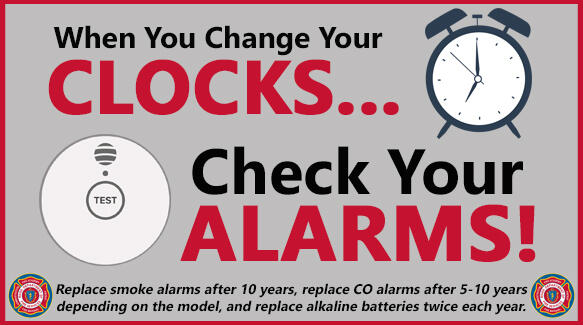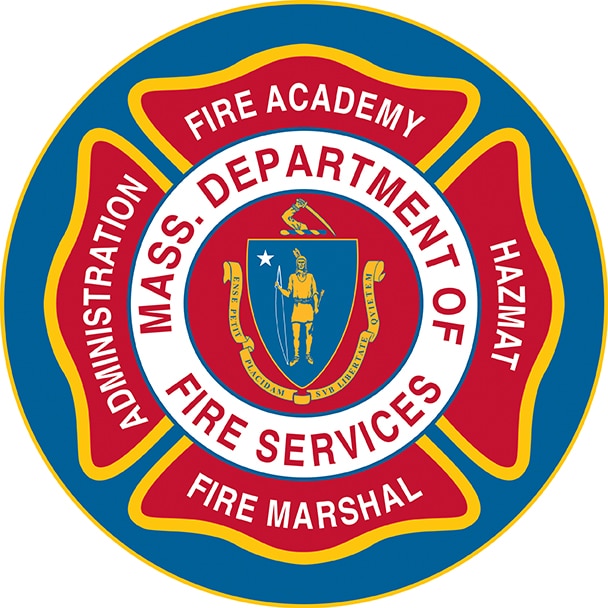- Department of Fire Services
Media Contact
Jake Wark, Public Information Officer

STOW — With the end of Daylight Savings Time just around the corner, State Fire Marshal Jon M. Davine and the Fire Chiefs Association of Massachusetts are reminding residents to check their smoke and carbon monoxide (CO) alarms when they change their clocks.
“Working smoke and CO alarms are your family’s first line of defense against an emergency at home,” said State Fire Marshal Davine. “As we ‘fall back’ this weekend, please take a few minutes to be sure you and your loved ones are protected.”
Modern smoke and carbon monoxide alarms have the manufacturing date printed on the back of the device. Smoke alarms should be replaced after 10 years, and CO alarms should be replaced according to the manufacturer’s instructions – usually 5, 7, or 10 years, depending on the make and model.
Fire officials are especially concerned about expiring smoke alarms because of a 2015 update to the State Fire Code. That update, which remains in effect, requires that replacement smoke alarms in most Massachusetts homes have sealed, 10-year batteries. As a result, the first wave of alarms purchased to comply with the update are nearing the end of their useful lifespan.
State Fire Marshal Davine and the Fire Chiefs Association of Massachusetts offered these tips for residents who are replacing outdated single-station smoke alarms. Following these guidelines will reduce the risk that someone will remove the batteries and place them in another device or to disable the alarm when it’s activated by cooking smoke:
- Choose photoelectric alarms from a well-known, national brand
- Look for the mark of an independent testing lab like UL or Intertek/ETL
- Select alarms with a sealed, long-life battery and a “hush” feature”
- Alarms that meet UL Standard 217, 8th edition or later, use the latest multi-criteria technology to reduce nuisance alarms caused by cooking smoke
If your alarms are less than 10 years old and take alkaline batteries, then put in fresh batteries to be sure you’re protected all winter long. And remember to test your smoke and CO alarms once a month to be sure they’re working properly.
Heating Season Brings Carbon Monoxide Hazards
Westborough Fire Chief Patrick Purcell, president of the Fire Chiefs Association of Massachusetts, emphasized the importance of working carbon monoxide alarms as we enter the colder months.
“Carbon monoxide is a leading cause of poisoning deaths in the United States, and heating equipment is the main source of carbon monoxide in the home,” Chief Purcell said. “We can’t see, smell, or taste carbon monoxide. Working CO alarms on every level of your home are the only way to detect this invisible killer.”
Massachusetts firefighters encountered carbon monoxide hazards at about 5,000 calls last year, Chief Purcell said.
Create & Practice a Home Escape Plan
“Changes to building construction and furnishings mean we have less time to escape a fire at home than ever before,” said State Fire Marshal Davine. “You could have just three minutes to get out safely.”
“Working smoke alarms and a practiced home escape plan are among the most fundamental and important tools for surviving a fire,” said Chief Purcell. “Be sure everyone in the home knows what to do and where to go when the alarm sounds, including young children, older adults, and persons with disabilities.”
Fire officials recommend planning two ways out of the building, the apartment, and each room if possible. Be sure to select a family meeting spot a safe distance from the building.
Senior SAFE
Adults over 65 are at disproportionate risk of death or serious injury in a fire, especially if they live in one- or two-family homes. Hundreds of fire departments across Massachusetts have grant-funded Senior SAFE programs that may provide assistance with smoke and CO alarms. Seniors who need help installing, testing, or maintaining their alarms should contact their local fire department or senior center for assistance.
For more information on smoke alarms or the Senior SAFE program, visit www.mass.gov/dfs or contact your local fire department.
###
